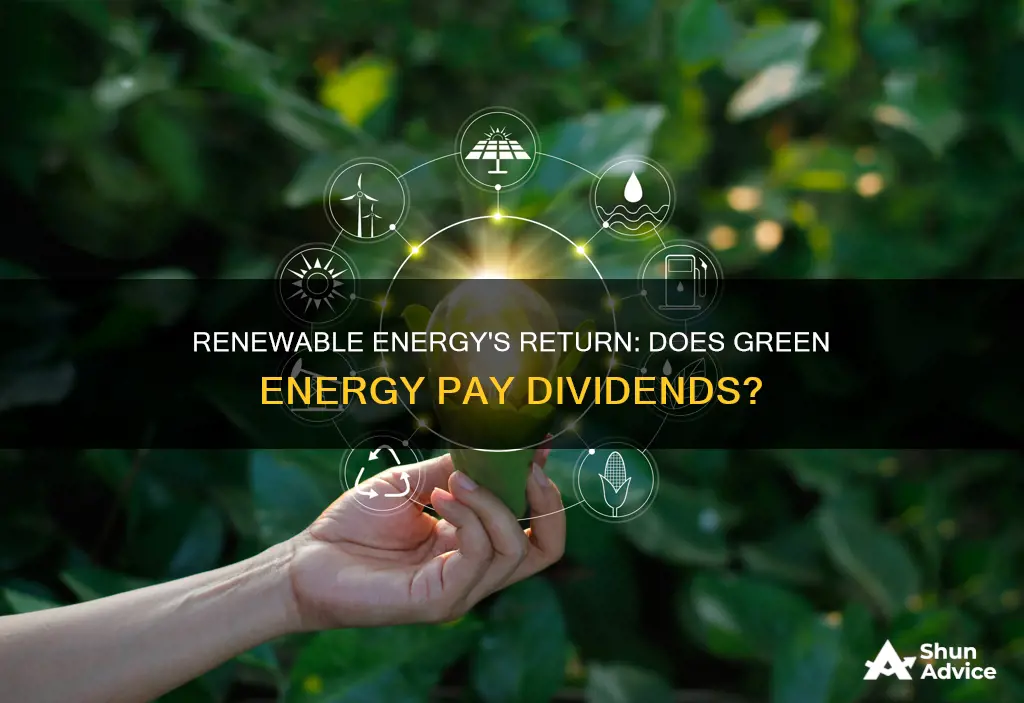
Investing in renewable energy is a hot topic. With the world facing an urgent need to transition to cleaner and more sustainable energy sources, investors are increasingly turning their attention to this sector. But does investing in renewable energy pay for itself?
The short answer is yes. Renewable energy investments have been shown to deliver significantly better returns than fossil fuels in the US, UK, and Europe. For example, a study by Imperial College London and the International Energy Agency found that renewable energy investments in Germany and France yielded returns of 178.2% over a five-year period, compared to -20.7% for fossil fuel investments.
Not only do renewable energy investments offer strong financial returns, but they also provide an opportunity to contribute to the fight against climate change and promote a more sustainable future. The demand for renewable energy is expected to grow as more businesses and households seek to reduce their carbon footprint, ensuring the long-term viability and profitability of these investments.
Additionally, government policies and incentives, such as tax benefits and subsidies, further enhance the attractiveness of investing in renewable energy. The decreasing costs of renewable technologies, such as solar and wind power, have also made it more feasible to turn profits in this sector.
However, it is important to note that the renewable energy market is still relatively young and may pose certain challenges and risks for investors. Nonetheless, with the world's growing commitment to addressing climate change, investing in renewable energy presents a compelling opportunity for those seeking both financial gains and a positive environmental impact.
| Characteristics | Values |
|---|---|
| Returns on investment | In Germany and France, renewable energy investments yielded returns of 178.2% over five years, compared with -20.7% for fossil fuel investments. In the UK, renewable energy investments generated returns of 75.4% over five years, compared to 8.8% for fossil fuels. In the US, renewable energy investments yielded 200.3% returns, compared to 97.2% for fossil fuels. |
| Volatility | Green energy stocks are less volatile than fossil fuels. |
| Market cap | In the US, the average market cap in the green energy portfolio is less than a quarter of the average market cap for the fossil fuel portfolio. |
| Demand | Demand for renewable energy is growing, driven by awareness of environmental issues and the need to meet international emissions reduction targets. |
| Job creation | The renewable energy sector is a significant driver of job creation. |
| Technological growth | The renewable energy sector benefits from rapid technological evolution, which increases the profitability of investments in the long term. |
| Government policies | Governments around the world are implementing policies to encourage investment in renewable energy, such as tax incentives and subsidies. |
| Energy independence | Investing in renewable energy contributes to a country's energy independence, reducing vulnerability to price fluctuations and the availability of imported fossil fuels. |
What You'll Learn

Green energy investments: the market, risks and returns
The Market
The market for green energy investments is growing, driven by rising global energy demand and the need to reduce carbon emissions. With temperatures expected to increase by over two degrees Celsius, many nations are seeking ways to replace fossil fuels with renewable energy sources. This provides a market opportunity for investors looking to profit from green energy investments.
According to a report by the United Nations Environment Program, global investment in transitional technologies reached $1.8 trillion in 2023. Wind, solar, and hydropower are the most promising technologies in the green energy market.
There are several ways to invest in green energy, including identifying individual companies that produce alternative energy technologies, or investing in a mutual fund or index fund with a large basket of green energy securities. Clean energy funds offer a convenient way to invest in a broad portfolio of energy companies.
Risks
One of the risks of investing in green energy is that the market is relatively young and untested. There may be limited information about the companies, and they may have short trading histories. Large asset managers and institutional investors may require deeper liquidity than the renewables market currently holds.
Another risk is price volatility. Clean energy stocks are expensive, and investors need a degree of faith before buying them. The low-interest rates set by the Federal Reserve have increased the stock prices of renewable energy companies.
Returns
Investing in renewable energy can offer massively better returns than fossil fuels. A study by Imperial College London and the International Energy Agency found that renewable energy investments in Germany and France yielded returns of 178.2% over a five-year period, compared with -20.7% for fossil fuel investments. In the U.S., renewables yielded 200.3% returns versus 97.2% for fossil fuels.
Green energy stocks are also less volatile than fossil fuel stocks and can provide a stabilizing force in an investment portfolio. The demand for renewable energy is growing, and investments in this sector are expected to continue to increase over the next few decades.
In addition to financial returns, investing in renewable energy offers ethical benefits and contributes to the fight against climate change.
China's Bubble: Global Investment Risk
You may want to see also

Fossil fuels vs renewable energy investments
Fossil fuels and renewable energy sources are two of the most prominent sources of energy in the world today. However, as the awareness of environmental issues and the need to meet international emissions targets grow, renewable energy sources are becoming more and more popular.
Fossil Fuels
Fossil fuels, such as coal, oil, and natural gas, have been the main sources of energy for many years. In 2019, oil and electricity were the two largest components of worldwide consumer spending on energy, with oil accounting for 50% and electricity for 38%. However, due to the Covid-19 pandemic, investment activity in the fossil fuel industry was disrupted, and revenues decreased sharply, especially for oil.
Renewable Energy
Renewable energy sources, such as solar, wind, and hydropower, are becoming increasingly popular as a more sustainable and environmentally friendly alternative to fossil fuels. The cost of renewable energy has also decreased over the years, with solar energy projects now able to generate power at about half the cost of fossil fuels.
Global investment in clean energy is expected to rise, with solar set to overtake oil production for the first time. Investment in clean energy technologies is outpacing spending on fossil fuels, with $1.7 trillion expected to be invested in clean technologies in 2023, compared to just over $1 trillion for coal, gas, and oil. This shift towards clean energy investments is driven by affordability and security concerns, as well as the global push towards more sustainable energy sources.
Benefits of Investing in Renewable Energy
There are several benefits to investing in renewable energy sources:
- Ethical and environmental benefits: Renewable energy sources are much cleaner than fossil fuels and can help reduce dependence on them, thus mitigating the impact of climate change.
- Economic growth: The development of renewable energy technologies creates new industries and drives job creation, stimulating the local economy.
- Technological growth: The rapid technological evolution in the renewable energy sector improves efficiency and increases the profitability of investments in the long term.
- Government incentives: Many governments offer tax incentives and subsidies to encourage the use of renewable energy sources, making it more financially attractive for consumers and businesses.
While fossil fuels have dominated the energy market in the past, renewable energy sources are now becoming more popular and affordable. With the increasing demand for renewable energy and the push towards a more sustainable future, investing in renewable energy sources can be a financially and environmentally sound decision.
NBA: Why Fans Don't Invest
You may want to see also

The future of renewable energy
Renewable energy is the future, and investing in it is an ethical choice that reflects a commitment to the planet's future. The sun, wind, water, waste, and heat from the Earth provide an abundance of natural renewable energy sources. These sources emit little to no greenhouse gases, are readily available, and are often cheaper than coal, oil, or gas.
The benefits of investing in renewable energy
Financial returns
The renewable energy sector is growing, and investments in this sector promise financial returns. The cost of renewable energy technologies is dropping, making it more attractive to investors and buyers. The price of solar energy has dropped, as has the cost of solar panels. Wind energy is also one of the fastest-growing and cheapest energy sources in the world.
Job creation
The renewable energy sector is a significant driver of job creation. The transition to net-zero emissions will lead to an overall increase in energy sector jobs. While about 5 million jobs in fossil fuel production could be lost by 2030, an estimated 14 million new jobs are expected to be created in clean energy, resulting in a net gain of 9 million jobs.
Improved health
Switching to clean energy sources helps address climate change and air pollution, which has significant health benefits. According to the World Health Organization (WHO), about 99% of people in the world breathe air that exceeds air quality limits, and more than 13 million deaths worldwide each year are due to avoidable environmental causes, including air pollution.
Energy independence and security
Encouraging the development of local energy sources, such as solar and wind, strengthens a country's energy security and promotes greater economic and political stability. About 80% of the global population lives in countries that are net importers of fossil fuels, making them vulnerable to geopolitical shocks and crises.
Technological growth
The renewable energy sector benefits from rapid technological advancements, which improve the economic viability of projects and increase the profitability of investments in the long term.
The challenges of investing in renewable energy
Despite the numerous benefits, investing in renewable energy also comes with some challenges. Here are a few considerations:
Initial investment cost
The upfront cost of investing in renewable energy can be high, especially for countries with limited resources. However, investments in renewable energy will pay off in the long run, as the reduction of pollution and climate impacts alone could save the world up to $4.2 trillion per year by 2030.
Infrastructure and grid integration
Integrating renewable energy sources into existing infrastructure and electric grids can be challenging. Adding large amounts of renewable energy to antiquated electric grids requires significant changes and investments.
Political and regulatory hurdles
The transition to renewable energy also faces political and regulatory challenges. Some politicians and interest groups oppose the shift to clean energy and promote the continued use of fossil fuels. Additionally, government subsidies and tax breaks for the fossil fuel industry can create an uneven playing field for renewable energy investments.
Despite the challenges, the future of renewable energy looks promising. With governments and private investors directing more funds towards clean energy technologies, the world is witnessing a rapid shift away from fossil fuels. As renewable energy sources become more efficient and cost-effective, they will play a crucial role in mitigating climate change and ensuring a sustainable future for generations to come.
Canon Inc.: A Smart Investment Choice
You may want to see also

Clean energy ETFs
- Xtrackers Net Zero Pathway Paris Aligned US Equity ETF
- JPMorgan Carbon Transition U.S. Equity ETF
- TCW Transform Systems ETF
- Nuveen Global Net Zero Transition ETF
- SPDR MSCI USA Climate Paris Aligned ETF
- SSGA SPDR S&P 500 Fossil Fuel Free ETF
- IShares Global Clean Energy ETF (ICLN)
- Invesco Solar ETF (TAN)
- Invesco WilderHill Clean Energy ETF (PBW)
- ALPS Clean Energy ETF (ACES)
- SPDR Kensho Clean Power ETF (CNRG)
The largest clean energy ETF is the iShares Global Clean Energy ETF (ICLN), with over $2 billion in assets under management. It takes a diversified, global approach to clean energy, investing in 100 stocks across the clean energy landscape, including solar and wind power firms, as well as utilities that operate significant green power facilities.
Another popular clean energy ETF is the Invesco Solar ETF (TAN), which focuses solely on solar energy. It has around $1 billion in assets and its holdings are split about 60/40 between the U.S. and international markets, with China as the second-largest jurisdiction.
Trump Investors: Winners or Losers?
You may want to see also

Government policies and renewable energy
Government policies and incentives are crucial in encouraging investment in renewable energy and facilitating the transition to a more sustainable energy model. Governments worldwide are implementing various measures to promote investment in this sector, recognising the urgency of addressing climate change and reducing dependence on fossil fuels.
One of the key ways governments are encouraging investment in renewable energy is through tax incentives and subsidies. These tax benefits reduce financial risk and increase the return on investment for those participating in the renewable energy market. For example, the US offers tax credits for specific projects, while Spain's favourable regulatory framework, combined with its abundant natural resources, makes it an attractive destination for renewable energy investments.
In addition to tax incentives, governments are also investing directly in the research, development, and deployment of clean energy technologies. The bipartisan infrastructure bill signed into law by the Biden Administration in the US in 2021 includes a $65 billion investment in cutting-edge clean energy technologies and transmission infrastructure. This type of government investment helps to accelerate the transition to renewable energy sources and creates opportunities for private investors.
Another way governments are promoting renewable energy investment is by including the sector as a priority sector in lending programmes. For example, in India, the Reserve Bank of India (RBI) norms include the renewable energy sector as a priority sector, which means banks are obligated to earmark a certain percentage of their lending for this sector. This facilitates access to finance for renewable energy projects and makes them more attractive investment opportunities.
Furthermore, governments are also implementing policies to promote the utilisation of renewable energy sources. For instance, the Electricity Act of 2003 in India mandates the State Commission to promote the cogeneration and generation of electricity from renewable sources and the timely update of the National Tariff Policy. Similarly, the National Electricity Policy of 2005 in India aimed to provide guidelines for the accelerated development of the power sector, with a focus on utilising maximum hydro potential in the country.
Overall, government policies and incentives play a pivotal role in driving investment in renewable energy. By offering tax incentives, direct investments, and favourable lending programmes, governments are creating an enabling environment for the transition to cleaner and more sustainable energy sources. These policies not only make renewable energy investments more financially attractive but also contribute to the broader goals of mitigating climate change, promoting energy independence, and fostering economic growth.
Retirement Account: Investing Beyond $5500
You may want to see also
Frequently asked questions
Investing in renewable energy is an ethical choice that reflects a commitment to the future of the planet. It helps reduce dependence on fossil fuels, mitigates the impact of climate change, and promotes a model of economic growth that respects the natural limits of our planet. It also stimulates the local economy and creates jobs.
The renewable energy sector is relatively young and untested, so there can be market risks and price volatility. Additionally, large asset managers and institutional investors such as pension funds require deeper liquidity than the renewables market currently holds.
There are several ways to invest in renewable energy, including shares on the stock market, investment funds, ETFs (exchange-traded funds), and crowdfunding. Some specific examples of renewable energy investments include:
- Brookfield Renewable Partners L.P. (BEP)
- Algonquin Power & Utilities Corp. (AQN)
- NextEra Energy Partners, LP (NEP)
- Clearway Energy Inc. (CWEN)
- Ormat Technologies, Inc. (ORA)
The renewable energy sector is expected to grow significantly in the coming years. Demand for renewable energy is increasing due to rising global energy demand and awareness of environmental issues. Governments around the world are also implementing policies to encourage investment in renewable energy, such as tax incentives and subsidies.







